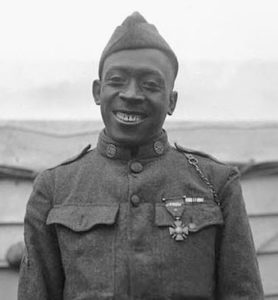
Henry L. Johnson
*Henry Johnson was born on this date in 1892. He was a decorated Black soldier in WWI.
Born in Winston-Salem, North Carolina, William Henry Lincoln Johnson moved to Albany, New York, in his early teens. He worked as a redcap porter at the Albany Union Station on Broadway. Johnson enlisted in the United States Army on June 5, 1917, joining the all-Black New York National Guard 15th Infantry Regiment, which, when mustered into Federal service, was re-designated as the 369th Infantry Regiment, based in Harlem. The 369th Infantry joined the 185th Infantry Brigade upon arrival in France, but the unit was relegated to labor service duties instead of combat training. The 185th Infantry Brigade was, in turn, assigned on January 5, 1918, to the 93rd Infantry Division.
Although General John J. Pershing wished to keep the U.S. Army autonomous, he "loaned" the 369th to the 161st Division of the French Army. Supposedly, the unreported and unofficial reason he was willing to detach the Negro regiments from American command was that white-American soldiers refused to fight alongside Black troops. Although they were all American citizens, these Black regiments suffered considerable harassment by white-American soldiers. Many Blacks died on American soil at their hands and were even denigrated by the American Expeditionary Force headquarters. They went so far as to release the notorious pamphlet Secret Information Concerning Black Troops, which "warned" French civilian authorities of the alleged inferior nature and supposed tendencies of Black troops to commit sexual assaults.
Johnson and other Black soldiers arrived in France on New Year’s Day, 1918. The French Army and the people were happy and welcoming in accepting the reinforcements. Among the first regiments to arrive in France, and among the most highly decorated when it returned, was the 369th Infantry (formerly the 15th Regiment New York Guard), which later became famous as the "Harlem Hellfighters." The 369th was an all-Black regiment under the command of mostly white officers, including their commander, Colonel William Hayward.
Charles W. Fillmore, a Black New Yorker, first proposed a Black New York National Guard regiment. Governor Charles S. Whitmore, inspired by the brave showing of the Black 10th Cavalry in Mexico, eventually authorized the project. He appointed Col. William Hayward to organize the unit, and Hayward gave Fillmore a commission as a captain in the 15th Infantry Regiment, New York National Guard. Before combat in France, the 15th New York Infantry Regiment became the 369th United States.
The 369th got off to a rocky departure from the United States, making three attempts for months to sail for France before finally getting out of sight of land. Even then, their transport, which had stopped and anchored because of a sudden snowstorm that arose before they could get out of the harbor, was struck by another ship due to poor visibility. The captain of the transport, the Pocahontas, wanted to turn back, much to the dismay of his passengers.
Col Hayward's men repaired the damage, and the ship sailed on, battered but undaunted. Col. Hayward notes they “landed at Brest. Right side up” on December 27, 1917. They acquitted themselves well once they finally got to France. However, it was a while before they saw combat. The French Army assigned Johnson's regiment to Outpost 20 on the edge of the Argonne Forest in the Champagne region of France and equipped them with French rifles and helmets.
While on guard duty on May 14, 1918, Private Johnson came under attack by a large German raider party, which may have numbered as many as 24 German soldiers. Johnson displayed uncommon heroism when, using grenades, the butt of his rifle, a bolo knife, and his bare fists, he repelled the Germans rescuing Needham Roberts from capture and saving the lives of his other fellow American and French soldiers. Johnson suffered 21 wounds during this ordeal. This bravery earned him the nickname "Black Death" as a sign of respect for his combat prowess. The story of Johnson's exploits first came to national attention in an article by Irvin S. Cobb entitled "Young Black Joe," published in the Saturday Evening Post on August 24, 1918.
Returning home, now Sergeant Johnson participated (with his regiment) in a victory parade on Fifth Avenue in New York City in February 1919. Johnson was then paid to take part in a series of lecture tours. He appeared one evening in St. Louis, and instead of delivering the expected tale of racial harmony in the trenches, he revealed the abuse Black soldiers had suffered, such as white soldiers refusing to share trenches with Blacks. Soon after this, a warrant was issued for Johnson's arrest for wearing his uniform beyond the prescribed date of his commission, and paid lecturing engagements dried up, too. Veterans Bureau records show that a "permanent and total disability" rating was granted to Johnson on September 16, 1927, as a result of his tuberculosis. Additional Veterans Bureau records refer to Johnson receiving monthly compensation and regular visits by Veterans Bureau medical personnel until his death. William Henry Johnson died in Washington, DC, on July 1, 1929. He was buried at Arlington National Cemetery on July 6, 1929.
On June 2, 2015, President Obama presented the Medal of Honor to Command Sgt. Maj. Louis Wilson of the New York National Guard on behalf of Private William H. Johnson because Private Johnson had no living relatives.